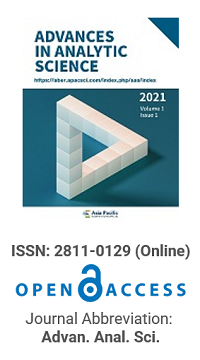
Publication Frequency
Semi-annual
Journal Content
Search
Search scope
Journal Center
Asia Pacific Academy of Science Pte. Ltd. (APACSCI) specializes in international journal publishing. APACSCI adopts the open access publishing model and provides an important communication bridge for academic groups whose interest fields include engineering, technology, medicine, computer, mathematics, agriculture and forestry, and environment.
Volume Arrangement
2024
Full Issue
| View or download the full issue |
by
Yadan Zou, Qingqing Xu, Ge Zhang, Fuyun Li, Fengmin Li
Adv. Anal. Sci.
2021
,
2(2);
339 Views
Abstract
Microplastic pollution has become a global environmental problem and is a cause of great concern. To evaluate the biological effects of microplastics, microplastics in organisms need to be accurately quantified. The quantification of microplastics in organisms using the fluorescence intensity is common; the digestion of biological samples is an important pretreatment method. However, the microplastics may be destroyed by digestion, which affects the fluorescence intensity of the microplastics and results in large deviations between measured and true values. In this study, six commonly used digestive agents were studied: KOH, N a OH , H 2 O 2 , HNO 3 , HNO 3 : hcl, and HNO 3 : HClO 4 . The effect of different digestion methods on the fluorescence intensity and surface morphology of microplastics was studied and the most suitable protocol was selected. The results show that, among the six different digestion methods, KOH digestion(100 g·L -1 , 60℃)has the least influence on the fluorescence intensity of the microplastics and does not affect their surface morphology. The other five digestion methods lead to different degrees of reduction of the fluorescence intensity of microplastics and damage the microplastics' surface(aggregation, bubbles, scratches, and depressions). In addition, the KOH digestion method was used to extract microplastics from biological samples. The recovery rate was≥96.3%±0.5%, indicating that the KOH digestion method is suitable for fluorescent microplastics in biological samples.
show more
by
Josep V. Mercader, Antonio Abad-Somovilla Abad-Somovilla, Consuelo Agulló, Antonio Abad-Fuentes
Adv. Anal. Sci.
2021
,
2(2);
71 Views
Abstract
Effective control of food quality and safety requires analytical methods that guarantee the reliable determination of any substance potentially harmful to the consumer that may be present in the food prior to its distribution and marketing. One of the analytical approaches that contributes to guarantee this objective encompasses a series of techniques that have in common the use of antibodies as essential elements for the detection of the target analyte, and which together are called immunochemical methods. This article aims to provide a basic overview of the biochemical principles underlying these technologies and their advantages and limitations in the determination of chemical contaminants, residues and additives in food matrices. The last part discusses some of our initiatives in this field that have resulted in commercially available rapid kits after transferring the corresponding technology to the industrial sector.
show more
by
Monica Moreno-Barriga, Andrés Noguera-Cundar, Lidia Castro-Cepeda
Adv. Anal. Sci.
2021
,
2(2);
45 Views
Abstract
The present study has as objective the analysis and characterization of a sample of an Ecuadorian feldspar, by means of XRD, SEM and TGA techniques, for the microstructural analysis of mineral phase and chemical composition. Qualitative and quantitative X-ray diffraction analysis by Rietveld refinement revealed that this feldspar is composed of 33.31% Albite, 15.70% Quartz and a large percentage by weight of 50.99% amorphous material. To validate these results, the uncertainty of the measurement was investigated and calculated by statistical analysis of standard deviation, giving as results an uncertainty error of ±0.87wt%, ±0.23wt% and ±0.89wt% respectively for the percentages by weight of the minerals found in this analysis. The result by SEM shows the presence of Albite in the feldspar exhibiting laminar twinning and characterized by randomly dispersed spherical quartz and plagioclase inclusions.
show more
Editor-in-Chief
1.jpg)
Prof. Sivanesan Subramanian
Anna University, India
Co-Editor-in-Chief

Prof. Pascal Lorenz
University of Haute Alsace, France
News & Announcements
2022-10-10
CISILE 2022 will be held in Beijing
The 20th China International Scientific Instrument and Laboratory Equipment Exhibition (CISILE 2022) will be held in Beijing National Convention Center on December 13-15, 2022, the exhibition is approved by Ministry of Commerce of the People's Republic of China.
2022-07-14
Canadian Society for Analytical Science and Spectroscopy(64th ICASS)
The 64th International Conference on Analytical Sciences and Spectroscopy will begin with a Monday morning plenary session, sponsored by PerkinElmer and Bergner Research, where awards will be presented.
2022-05-02
ARF22 will be held in June
Analytical Research Forum 2022 (ARF22) will be a hybrid event, allowing both in-person and online participation. on June 13, 2022, there will be an online event that includes a career panel discussion; on June 14, 2022, at Burlington Court or online for an invited lecture and early career contribution.


 Open Access
Open Access